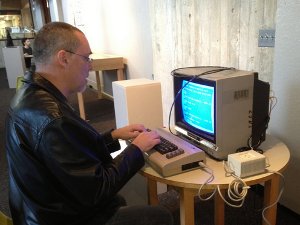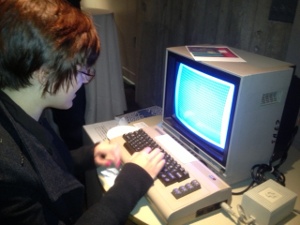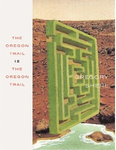Kathi Inman Berens storified some nice media elements relating to the 2013 electronic literature exhibit and reading at the MLA Convention.
Canonical Hypertext, IF, and Digital Narrative
What is it that those who have it hate it and oppose it, but those who lack it desperately want it and imagine it?
A canon.
Deb Chachra called my attention to Infovore’s new canonical list of “hypertext literature / interactive fiction / digital narrative.”
I certainly don’t object to the exercise of blog-based canon development. Back in 2004 I presented a canon-like list of Atari VCS games. Thinking up the list and discussing it online were very useful to me as I started formulating the book I’d later write with Ian Bogost, Racing the Beam. Some of the discussion was “what about this game, why not that game?,” as one commenter noted, but really not much of it – more often we ended up discussing why the focus on the Atari VCS, or what qualities make a game worth studying, or how gameplay and graphics/sound interact, etc.
So, instead of offering any substitute items for the list provided, I’ll just try to mention an aspect of “canon” that Infovore has already picked up on. The best idea in developing such lists seems to be not to pick the greatest hits or the first at doing something or the most widely cited, but rather to choose those productions that are interesting to compare to others.
A canon is a standard, as the OED offers: “c. A standard of judgement or authority; a test, criterion, means of discrimination.” So, it would make sense to me to select works that are, for example, the best at political discourse, or engagement with language, or formal innovation, or critique and transformation of existing work – or whatever aspects of interactive literature one values. What would you hold up as an example of avant-garde writing practices meeting interactivity, for instance, after 1961? What’s the standard for work that engages with contemporary political issues?
New 10 PRINT Story from the MIT Libraries
The MIT Libraries have posted a story on 10 PRINT that includes discussion of the book from Patsy Baudoin and me, describes how the project came amount, and gives the latest information on how royalties are being donated. The story was written by Katharine Dunn.
10 PRINT Marches on
The news service of my school at MIT, the School of Humanities, Arts, and Social Sciences, has an article about 10 PRINT CHR$(205.5+RND(1)); : GOTO 10.
Also, there has been some furious and pretty amazing program creation and compaction going on in DOS/x86 land. It all seems to have started when demoscener Trixter (a.k.a. Jim Leonard) decided to port 10 PRINT to x86 assembly. His first, straightforward version was 42 bytes long, but he was quickly able to chop it down by replacing the random number generator with a single instruction: 25 bytes. Getting ready of some of the nice and tidy but strictly unnecessary startup and shutdown code brought the program down to 15 bytes. Then, thanks to the clever use of an opcode that I’d never heard of before which is meant for string comparison and is called SCAS, he was able to trim the code to 13 bytes — the shortest he thought it could ever be.
Of course, someone (Peter Ferrie) found a way to get rid of another byte, so the program sat at 12 bytes long.
herm1t came along to provide an optimization that assumed DOS was loaded, reducing the program to 11 bytes.
And, most recently, Peter Ferrie returned to lop off another byte, showing that the program (on Intel CPUs, at least) need only be 10 bytes long.
Trixter provides the full story (so far!) on his blog, Oldskooler Ramblings.
My joke about this is that the shortest possible 10-PRINT-like program will be a single jmp instruction to a run of 8 or 9 bytes that happen to already be in memory. However, this is probably only a joke: the number of possible 8-byte combinations of bits are 256^8 = 18446744073709551616, so it really isn’t very likely, even for an extremely short program of this sort, that it will just happen to be lying around somewhere in memory initially.
Speaking of the demoscene, I mentioned in my last post that viznut has checked out the book. He’s also written a very nice VIC-20 version of the program that uses two of the tiles from the Black Path Game instead of the original diagonal lines:
0 FORI=7168TO7183:READA:POKEI,A:NEXT:POKE36869,255
1 PRINTCHR$(64.5+RND(.));:GOTO1
2 DATA16,16,32,192,3,4,8,8,8,8,4,3,192,32,16,16
The result:
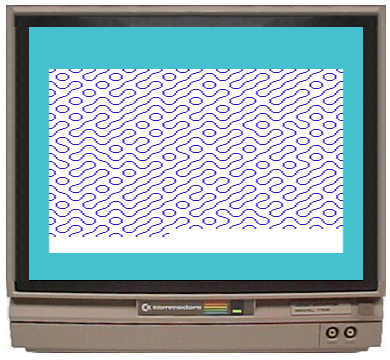
Finally, we had a great time exhibiting the 10 PRINT program and the 10 PRINT book at the 2013 MLA’s electronic literature exhibit and presenting the program and modifications of it at the MLA offsite electronic literature reading. Thanks to Dene Grigar and Kathi Inman Berens for curating the exhibit and the reading. And, thanks to Patsy Baudoin, Mark C. Marino, and Mark Sample for joining me for that presentation and for offering commentary (play-by-play and color) as I coded on the Commodore 64.
Flores on Sea and Spar Between
Leonardo Flores has posted a nice discussion of Sea and Spar Between (by Nick Montfort and Stephanie Strickland) on his blog, I ♥ E-Poetry.
Radical Books of 2012 (3/7)
Rise of the Videogame Zinesters: How Freaks, Normals, Amateurs, Artists, Dreamers, Drop-outs, Queers, Housewives, and People Like You Are Taking Back an Art Form
Anna Anthropy
Seven Stories Press · 208 pages
The discussion of mainstream gaming in this book, while it isn’t exactly generous, covers both what is produced and the labor issues of how it is produced. The book’s DIY instructions point readers to tools and sketch the simplest sorts of development processes. (Such pointers may be what a book does best, as there is plenty of relevant information online.) What makes this book valuable and radical (other than the conceptual writing exercise cataloging game topics on pp. 137-139) is the amazing world it presupposes in which Halo and Bioshock can go unmentioned while there are pages about Anthropy’s Gay Sniper. Unofficial games made by individuals are shown to be part of culture and the politial and social discourse. Beyond newsgame and artgame, although not detached from some of their tactics, are many short experiments, games about “putting down your dog” that speak to everyday experience. Games that say what you want them to say and not games that say what someone else wants you to say.
10 PRINT “HAPPY NEW YEAR”
Happy new year!
A few updates related to our book 10 PRINT CHR$(205.5+RND(1)); : GOTO 10 …
Booksellers had some problems keeping the book in stock in recent weeks. The MIT Press is addressing this by printing more copies.
We learned in November, and were recently reminded by Finnish scener and programmer of one-liners viznut, that there is a pre-Commodore 64 version of the program. It’s in a fairly obvious place, too: The VIC-20 User’s Manual, on page 102. The program is identical to the first variant in our book (Variant 1982) except that the line numbers are 10, 20, and 30 instead of 10, 20, and 40. This wasn’t a big surprise to us, as we knew since early in the process of writing the book that the program worked not only on the Commodore 64 but also on the VIC-20 and the PET. It would have been nice to have documented this variant in the book, of course.
mjcohenw on Hacker News states that the program originated even earlier:
I discovered this on my Commodore PET probably about 1980 and presented it at a users’ group meeting (in the Los Angeles area). I have no way to prove this right now, but I swear that this is true.
So, there’s a testament to the program being written and shared on the PET even earlier. That it comes from human memory, and not from some print source, should be no surprise to readers of 10 PRINT.
Finally, I’ll note that 10 PRINT appears as one of the “creation stations” at the 2013 Modern Langauge Association Convention. The exhibit it’s in, Avenues of Access: An Exhibit & Online Archive of New ‘Born Digital’ Literature, will be in room 312 in the Hynes Veterans Memorial Convention Center. Exhibit times are:
Thursday, 3 January, 12 Noon to 7:00 p.m.
Friday, 4 January, 9:00 a.m. to 7:00 p.m.
Saturday, 5 January, 9:00 a.m. to 7:00 p.m.
The exhibit closes on Saturday afternoon and will not be open on Sunday.
There will be a reading to accompany the exhibit on Friday night, 8 p.m. to 10 p.m., at Emerson College’s Bordy Theatre, 216 Tremont Street. 10 PRINT will be part of that and will be presented by five of the book’s co-authors.
Radical Books of 2012 (1/7)
The Oregon Trail is the Oregon Trail
Gregory Sherl
Mud Lucious Press · 65 pages
Consciousness wobbles between the “real world” of Barry Manilow concerts, streetscapes that look like Frogger, and private Facebook messages on the one hand and a fabled simulation bleeding beyond the phosphors of the computer-connected CRT television on the other. Amid tender moments featuring the wife, child #1, and child #2, these poems also offer reminders of the political context in which Westward expansion was undertaken. “The Oregon Trail 2 Starring Mel Gibson Directed by Mel Gibson” notes, for instance, “We have Manifest Destiny in our cocks.” This book about the American journey, not the destination, may appear to be a nostalgic romp. (Perhaps the book’s dedication, “FOR YOUTH,” and the theme of adult responsibilities invites such an attitude.) There is no home to ache over, though, in these 39 poems that join intimate imagination to a famous if floppy American document, showing that however personal or national memory flows past, in whatsoever form, you can’t ford the same river twice.
The Gorge in Review, and in Remix
Leonardo Flores has now written 22 posts (one each day, as is his wont over at “I ♥ E-Poetry”) on Taroko Gorge and its various remixes.
Quite a critical outpouring, considering that Taroko Gorge was originally a one-day project!
Leonardo also presents TransmoGrify, another remix of Taroko Gorge that narrates the programming and remixing of these 22 poem generators, producing stanzas such as this one:
Mark inverts the line.
Sonny Rae experiments.
Judy intervenes upon the variable.
With the absolute ♥ of the e-poetry of life butchered out of their own bodies good to eat a thousand years.
Purple Blurb Spring 2013: McIntosh, Di Blasi, Henderson
Thanks to the good work of guest organizer Gretchen Henderson, the Purple Blurb schedule for Spring 2013 is already set! I hope to see you locals at some or all of them.
All Spring 2013 events are Mondays at 5:30pm in MIT’s room 14E-310. This is in the East wing of Building 14, across the building’s courtyard from the Hayden Library. Building 14 is not part of the Media Lab Complex. The Spring 2013 schedule is thanks to guest organizer Gretchen Henderson.
February 11, 5:30pm in 14E-310
Jason McIntosh
Presents the Interactive Fiction “The Warbler’s Nest”

Jason McIntosh is an independent games critic, designer, and scholar. During the previous decade, he produced “The Gameshelf”, a public-access TV series examining both tabletop and digital games, and “Jmac’s Arcade,” a set of video monologues on growing up within the arcade culture of the 1980s. More recently, he’s taught a game-studies lab at Northeastern University, published the XYZZY Award-winning work of interactive fiction “The Warbler’s Nest”, crafted the iPad edition of the tabletop game “Sixis” by Chris Cieslik, and worked as a game-design consultant for other clients. He continues to write game-criticism essays on The Gameshelf’s blog, and produces the occasional episode of the podcast series “Play of the Light”, which he co-hosts with Matthew Weise. His website collecting all this stuff may be found at jmac.org
March 11, 5:30pm in 14E-310
Debra Di Blasi
“Skin of the Sun: Five Iterations Toward Human As Novel”
Followed by a discussion of the literary publisher’s role in the 21st Century

Debra Di Blasi is a multi-genre, multimedia author of six books, including The Jirí Chronicles & Other Fictions, Drought & Say What You Like, and Skin of the Sun. Awards include a James C. McCormick Fellowship in Fiction from the Christopher Isherwood Foundation, Thorpe Menn Book Award, Cinovation Screenwriting Award, and Diagram Innovative Fiction Award. Her fiction is included in a many leading anthologies of innovative writing and has been adapted to film, radio, theatre, and audio CD in the U.S. and abroad. Her essays, art reviews and articles can be found in a variety of international, national and regional publications. She frequently lectures on the intersection of literature and technology and is working on a nonfiction book on related topics.
April 8, 5:30pm in 14E-310
Gretchen E. Henderson
“Galerie de Difformité:The Book as Body, The Body as Book”
Followed by an OPEN MIC!

Gretchen E. Henderson is a Mellon postdoctoral fellow at MIT and a metaLAB fellow at Harvard, who writes across genres, the arts, and music to invigorate her critical and creative practices. She is the author of two novels, The House Enters the Street and Galerie de Difformité (winner of the Madeleine Plonsker Prize), a collection of nonfiction, On Marvellous Things Heard, and a poetry chapbook, Wreckage: By Land & By Sea. Among other projects at MIT, she is working on Ugliness: A Cultural History (for Reaktion Books), while continuing the collaborative deformation of Galerie de Difformité: a print book that is interfacing with the history and future of the book, networked online, inviting readers to participate in its (de)formation across media.
Someone Hearts Taroko Gorge
Leonardo Flores of I ♥ E-Poetry is writing about 18 remixes of Taroko Gorge, one each day for the next 18 days.
What’s the Story on Digital Media?
I generally will reply to any email messages that was personally written to me and which requests a reply. Perhaps because I wrote for my college newspaper, I’m inclined to try to help student journalists when I can. Sometimes, though, the best suggestions I can offer are ideas about how to rethink the basic approach and find a real story, rather than the sought-after quotations. As when, recently, I wrote basically this in reply to some extremely general questions about digital media and changes in the way we communicate – perhaps prompted by a class assignment rather than part of work toward an article for publication:
Grouping together Facebook, blogs, and text messages on one side and letter-writing on the other isn’t really sound, since it assumes that Facebook, a blog, and a text message are the same sort of thing and that a letter is a different sort of thing. Is a letter typed on a word processor the same as or different from a hand-written letter? Is one a digital media letter and the other pre-digital? Why is publishing a long, public blog post at all like sending a text message to a friend?
Your questions also suggest that people are constantly making choices between using digital media and traditional media. We live in a media ecology in which old media are not simply replaced by new. There are many ways to communicate, but we very seldom choose one over the other. I suppose there are circumstances under which you might send a friend a postcard, for instance, but I find it very unlikely that you’d make a direct and conscious decision to do that instead of sending that friend a text message.
Your questions also seem to assume that new media technologies just appear and that we are influenced by them, because you ask only about the effects of these technologies. Facebook was not given to the Earth by aliens, though. It was developed by people based on existing ideas about communication. The same can be said for the Web and any other digital communication system. Someone who is interested in knowing why communication online is the way that it is will never figure that out just by asking about how Facebook influences the way people write. It’s also necessary to understand why Facebook came to be the way it is, in terms of its original motivation and development and down to specific questions (such as your last one) related to particular features.*
I would suggest focusing on a particular digital media system and asking about how it arose, how it is used, and what’s special about it — not just in relation to some non-digital means of communicating, but overall. It can be worthwhile to ask what niche such a system has in the media ecology: What does it offer in particular that is better than other media channels? Then, you can see how people use language within that channel in interesting ways that is revealing in terms of culture, cognition, and so on. The people who study these systems successful in the humanities and social science, and those who build them and do well at it, take this sort of approach, and there are certainly interesting stories that result about why certain systems are successful in certain ways and how they are actually used.
The paragraph marked with *, of course, is just as true for computational platforms (the focus of the platform studies approach and the MIT Press Platform Studies series) as it is of communications systems, and it’s one of the core ideas behind platform studies and what it comprehends.
This student didn’t seem interested in approaching the topic differently and more productively, and asked instead if I could recommend someone who would provide quotes. That’s not a surprise – it’s the typical nature of this exchange, after all, and not a desire to roast any (unnamed) person, that motivates me to post this. It does go to show that whether you use in-person interviewing, an analog land-line phone, or email, you can miss gaining insight in the same way.
Submit to E-Poetry!
The deadline for E-Poetry 2013 (to take place in London, at Kingston University) is almost here – sumissions are due December 1. The festival will take place June 17-20.
10 PRINT Exhibit, Reading
Our book 10 PRINT CHR$(205.5+RND(1)); : GOTO 10 has been printed and bound and is making its way to bookstores now. It’s featured in a current exhibit at Hampshire College, and three of us ten co-authors did a reading to celebrate the release at the Harvard Book Store yesterday, where the first copies were available.
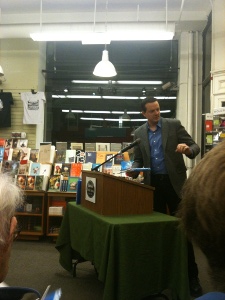
Our reading at the Harvard Book Store drew a sizable crowd, including MIT colleagues from Comparative Media Studies / Writing and Humanistic Studies and the Literature section; comrades in the People’s Republic of Interactive Fiction, librarians, and local free software folks and hackers, among others. The three of us read some short excerpts from the book and discussed the project, first with each other and then in response to questions from the audience. Several people assumed that the book was a collection of individually-authored articles, which is not a surprise, since that’s usually how a book like this is done. So we spent some time explaining the process of collaborative authorship that we used. The photos here are of me (Nick Montfort) on the left, then of Patsy Baudoin and Noah Vawter.


Meanwhile, back in Western Massachusetts … and specifically at Hampshire College, the exhibit “Pulp to Pixels: Artist’s Books in the Digital Age” is on until November 16. The exhibit is curated by Andrea Dezsö, Steven Daiber, and Meredith Brober, is part of the “Non-Visible and Intangible” series, and is located at the Harold F. Johnson Library. There’s a news item about the exhibit and site with curatorial descriptions and documentation.
Below are photos of John Slepian, who offered his Commodore 64 for the exhibit and set it up, and a gallery visitor enjoying a 10 PRINT variant.
